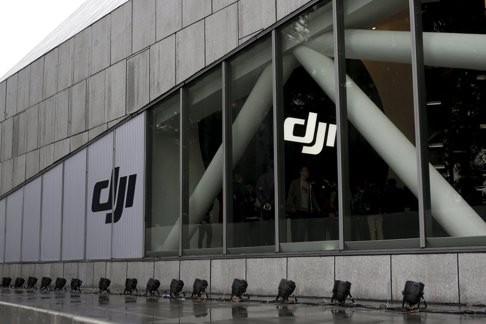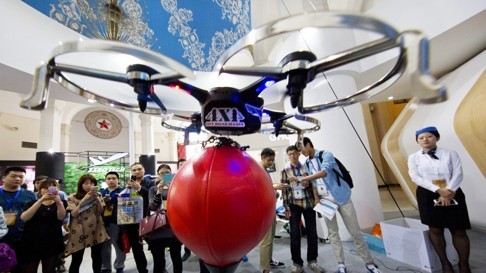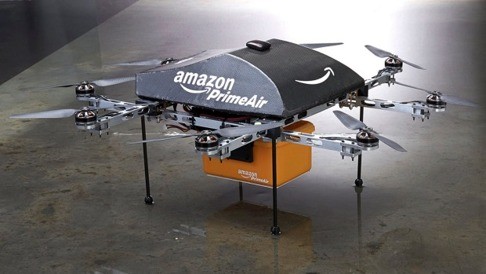Drone wars to hit new heights in 2016 as global market expected to double, with wider applications

Chinese makers of civilian drones expect the global market to double in size annually for the next few years at least as the gadgets find new applications.
DJI, which controls over 70 per cent of the world market for commercial drones, recorded a strong performance in 2015 but expects to do even better in 2016.
Other drone makers also based in Shenzhen, in southern China’s Guangdong province, seem to be singing from the same hymn sheet. The city is responsible for the majority of global drone shipments.
Many of these small - and not so small - start-ups are expecting to cash in as the industry continues to innovate and uses for drones are found in more fields. DJI already has a valuation in excess of US$10 billion.
Manufacturers in Shenzhen exported civilian drones worth a total of 2.3 billion yuan (US$354 million) from January to October, marking a more than 10-fold expansion from the same period in 2014.
“We have grown three to five times year-on-year in terms of revenue, and that trend ran from 2009 until last year. We are very optimistic that such growth will continue in the coming years,” said DJI spokesman Wang Fan.
“A few years ago, no one knew drones could be used in firefighting, agriculture and for inspection purposes,” he added.
WATCH: DJI - Phantom X Concept
“Every new application can bring tremendous change to a traditional industry and its employment levels.”
US-based Consumer Electronics Association forecasts the global market for consumer drones will approach US$300 million by 2018.
DJI launched its Software Development Kit (SDK) recently to provide free solutions for professional users and developers in a bid to broaden the market and create customised apps for the company’s aerial platforms, it said.
It has already yielded fruit in helping DJI improve map creation for mining, warehouse inventory scanning for logistics, parking inspection, and more.
Now more domestic players are spending lavishly on research and development to corner niches of the market.
Zhang Jie, CEO of GUAV Intelligent Technology, said her company spent 7 million yuan, or more than 17 per cent of its sales volume this year, on developing original and creative high-end designs.
“I think our sales volume next year will see at least 30 per cent growth. We will definitely invest 20 per cent or more on R&D in 2016.” she said.
“DJI launched its first drone designed for agricultural use in November, but GUAV had already commercialised an agricultural-use drone of ours back in May,” she added.
“You can image how big the market would be in China if every of town or village government purchased one.”
She said that hundreds of small tech firms have been eyeing the market for small commercial drones in recent years, with many adapting DJI’S design to their products. But it only leads to price wars and thin profit markets, she said.
“The potential market is huge with generous profits. But the key to winning is innovation, not pushing out copycats,” Zhang said.
She expects many smaller players to go under in 2016 while growing capital from big companies will see greater innovation at the top end of the market.
Her company plans to launch a commercial drone in January priced at 5,900 yuan that can run on 4G mobile networks. It will be able to avoid obstacles and offer flight times of up to 38 minutes, making it better than DJI’s wildly popular Phantom 3, she said.
“Our team is designing a drone for medical rescue purposes that can carry emergency personnel with a first aid kit. It could be a six –axis, fuel-powered model that can carry payloads of up to 50 kilogrammes and fly at altitudes of up to 300 metres,” she said.
“We hope to work with major state-run hospitals and get approval from China’s transport ministry by 2017.”
China is also advancing its development and employment of unmanned aerial vehicles (UAVs) for military use.
According to the estimates from the Pentagon, China plans to produce upwards of 41,800 land- and sea-based unmanned systems, worth about $10.5 billion, between 2014 and 2023.
China’s biggest drone maker, Aviation Industry Corp of China (Avic), has been tipped by Forecast to become the world’s largest maker of military drones by 2023.
According to Chinese news reports, domestically produced military drones including the CH-3 and CH-4, as well as the Wing Loong drone made by Chengdu Airplane Design Research Institute, have already been exported to countries like Pakistan and Myanmar.
Watch: Footage of Singapore Post’s delivery drone test
The Wing Loong can reportedly reach altitudes above 5,000 metres, fly for 20 hours and carry loads of up to 200 kg. Meanwhile, the People’s Liberation Army has touted the CH-4 as being superior to the US-made MQ-1 Predator.
The Wing Loong sells for US$1 million. It’s often compared to the US-made MQ-9 Reaper, which costs about 30 times as much.
Military experts say the Chinese drone can help Beijing strengthen its intelligence-gathering capability in the East China Sea and South China Sea, where China is dealing with several tense territorial disputes with its Asian neighbours.
But China’s military drones still lag behind their US counterparts in terms of cutting-edge tech due to a lack of advanced sensors and powerful engines, according to local experts.


